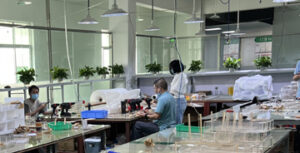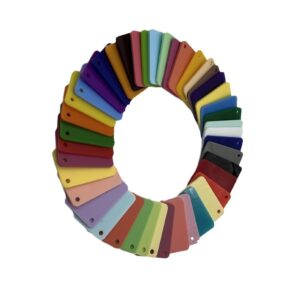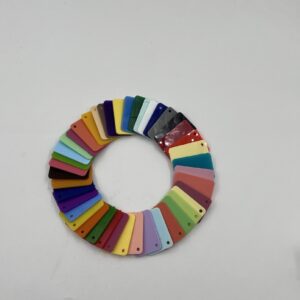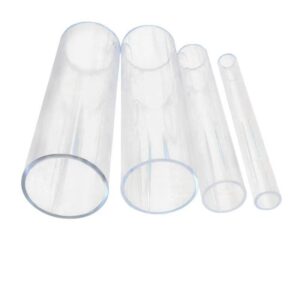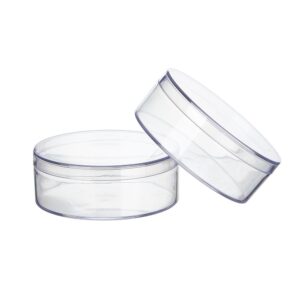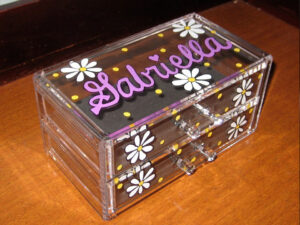Summary
Acrylic, often marketed under the brand name Plexiglass, is a versatile and transparent thermoplastic known for its exceptional clarity, durability, and lightweight properties. As a prominent alternative to traditional glass, acrylic’s impact resistance and shatterproof characteristics have made it increasingly popular across various industries, including automotive, aerospace, and retail. This material’s unique qualities not only cater to practical applications but also enhance aesthetic appeal in interior design and advertising, positioning acrylic as a key player in contemporary material science.
Notably, acrylic stands out for its weather resistance and UV protection, allowing it to withstand prolonged exposure to sunlight without fading or degradation. Its environmental benefits, including recyclability and a lower carbon footprint, further enhance its appeal in a world increasingly focused on sustainability. However, despite its advantages, the manufacturing processes of acrylic, including cell casting and extrusion, lead to distinct material characteristics, pricing discrepancies, and performance outcomes, complicating choices for consumers and businesses alike. While both acrylic and Plexiglass share common features, the terminology often leads to confusion in application and perception. Understanding the differences in cost, maintenance, and installation requirements is critical for professionals in fields ranging from construction to art, where material selection directly impacts project outcomes. Controversies also arise regarding the environmental impact of production processes and the durability of different types of acrylic, necessitating informed decision-making in material procurement.
In summary, acrylic’s blend of clarity, strength, and environmental consciousness solidifies its importance in modern applications, while ongoing innovations and practices continue to shape its role in sustainable design and manufacturing. As industries evolve, so too does the dialogue surrounding acrylic and its implications for future material choices.
Table of Contents
Properties
General Characteristics
Acrylic, also known as polymethyl methacrylate (PMMA), is a transparent thermoplastic that exhibits a remarkable blend of clarity, durability, and versatility. This material is increasingly favored over traditional glass in various applications due to its lightweight nature and shatter-resistant qualities. The high impact resistance of acrylic sheets makes them suitable for demanding environments, ensuring structural integrity under physical stress, such as wind and impact.
Weather Resistance
One of the standout features of acrylic is its exceptional weather resistance, which includes superior UV protection. Unlike glass, acrylic can endure prolonged exposure to sunlight without succumbing to fading or degradation. This quality is especially crucial in outdoor applications in regions like South Africa, where the sun’s intensity is high. Acrylic sheets maintain their clarity and color retention over time, making them ideal for vibrant signage displays and protective barriers.
Thermal Properties
Acrylic exhibits specific thermal properties that must be considered in design applications. With a softening point ranging from $160-180^{\circ}C$ ($320-356^{\circ}F$) and a continuous usage temperature of below $80^{\circ}C$ ($176^{\circ}F$), acrylic is not suitable for high-temperature environments. Its thermal expansion coefficient is approximately 0.000075 $mm/mm/^{\circ}C$, which is higher than that of glass, necessitating careful planning in environments subject to significant temperature fluctuations.
Environmental Considerations
The recyclability and eco-friendliness of acrylic sheets are increasingly important in today’s construction landscape. Many manufacturers are now offering eco-friendly options that meet environmental regulations, ensuring that these materials can be sustainably sourced and reused. Acrylic’s combination of durability and environmental considerations positions it as a forward-thinking choice for modern construction and design.

Applications
Acrylic and Plexiglass, while often used interchangeably, have distinct applications across various industries due to their unique properties.
General Uses
Both materials are widely utilized in automotive and aerospace industries for applications such as windows and windshields where clarity and strength are essential. Additionally, they are commonly found in consumer electronics, including mobile phone covers and other components, reflecting their versatility. In the realm of retail, acrylic sheets are favored for displays due to their lightweight, durable, and visually appealing nature, making them ideal for showcasing products effectively.
Specialized Applications
Acrylic and Plexiglass also serve specialized functions. In the medical field, they are used in the production of medical devices and equipment, owing to their biocompatibility and ease of sanitization. Their optical clarity is advantageous for optical lenses and instruments, while their impact resistance makes them suitable for bullet-resistant barriers and windows. Furthermore, both materials excel in signage and advertisement applications, where their weather and UV resistance ensure durability and visual appeal.
Interior Design
In modern interior design, acrylic has emerged as a popular choice for partitions and wall cladding. It provides a sleek, contemporary look while allowing natural light to permeate spaces, making it a practical alternative to traditional materials in offices, homes, and commercial environments. Its aesthetic versatility allows for creative designs that can enhance interior spaces without compromising on functionality.

Environmental Impact
The environmental impact of acrylic and plexiglass has become a crucial topic in discussions about sustainable materials in construction and manufacturing. This assessment aims to evaluate the environmental impact of plexiglass throughout its lifecycle and assess its contribution to climate change. While these materials are often considered to pose sustainability dilemmas due to their fossil fuel origins, they also present significant eco-friendly aspects that warrant attention.
Recyclability and Resource Conservation
A key advantage of acrylic and plexiglass is their recyclability, which allows these materials to be repurposed repeatedly without significant degradation in quality. Recycling programs typically involve collection, cleaning, and reprocessing into new sheets, creating an eco-friendly cycle that minimizes landfill contributions. Closed-loop recycling systems have emerged as a priority among many manufacturers, ensuring that scrap materials are reincarnated into usable products, thereby aligning with global efforts to promote a circular economy.
Durability and Waste Reduction
The durability of acrylic sheets contributes to a reduction in waste over time. Because they are less likely to degrade compared to traditional plastics, using colored acrylic sheets can significantly diminish the ecological footprint of construction projects. Additionally, their lightweight nature leads to lower energy consumption during transportation and installation, further reducing their overall environmental impact.
Challenges of Production
Despite their benefits, the production of acrylic and plexiglass is not without challenges. The extraction and processing of fossil fuels for acrylic production contribute to pollution and the release of harmful fumes. This aspect poses a significant sustainability dilemma, highlighting the need for responsible production practices within the industry.
Commitment to Sustainable Practices
As awareness of environmental issues continues to grow, the manufacturing industry is increasingly committed to eco-conscious practices. Efforts to utilize cleaner energy sources and refine recycling techniques significantly reduce greenhouse gas emissions associated with production. This commitment to sustainability reflects an industry-wide recognition that embracing responsible practices is not just a moral imperative, but also essential for economic viability in the face of mounting environmental concerns.

Manufacturing Processes
Acrylic can be produced using two primary methods: cell casting and extrusion, each yielding distinct properties and applications.
Cell Casting
Cell casting is a more intricate and labor-intensive manufacturing process. This method involves assembling glass cells and filling them with a viscous liquid composed of methyl methacrylate (MMA). The filled cells are then cured under pressure, resulting in high-quality cast acrylic sheets with superior optical clarity and mechanical properties. Cast acrylic is known for its durability, stability, and resistance to thermal stress, making it ideal for high-end applications and intricate designs. One of the main advantages of cast acrylic is its excellent optical properties, as it allows for up to 92% light transmission, which is comparable to glass. This makes it a popular choice for applications where clarity is paramount, such as display cases and high-quality signage. However, due to the complexity of the cell casting process, cast acrylic is typically more expensive than its extruded counterpart.
Extrusion
In contrast, the extrusion process involves continuously forcing heated acrylic polymer through a die to create sheets with a uniform thickness. This method is less costly and allows for faster production, which makes extruded acrylic sheets a more accessible option for many manufacturing projects. Extruded acrylic tends to be softer and more prone to scratching compared to cast acrylic, but it is often favored for its affordability and ease of machining. Extruded acrylic sheets are generally impact-resistant, making them suitable for applications in outdoor installations and high-traffic areas. While their optical quality may not match that of cast acrylic, extruded sheets are still used widely across various industries due to their balance of performance and cost-effectiveness.

Comparison
The choice between cell cast and extruded acrylic largely depends on the specific requirements of the project, including budget considerations and desired material properties. While cell cast acrylic offers superior clarity and strength, extruded acrylic provides a more economical and flexible alternative for a variety of applications. As the demand for sustainable manufacturing continues to grow, both methods are evolving to enhance their efficiency and reduce environmental impact, making acrylic a prominent material in the realm of responsible production.
Cost Comparison
When evaluating the costs associated with acrylic and plexiglass, several factors come into play, including material pricing, manufacturing processes, and long-term value. Generally, acrylic is considered the more affordable option, often priced around half that of plexiglass for equivalent sheet sizes. This cost efficiency is primarily due to acrylic’s thermoplastic nature, which allows for easier shaping and molding during manufacturing, thus reducing labor costs and overall expenditure.
Initial Costs
The average cost of acrylic sheets ranges from $1.50 to $2.00 per kilogram, making it a budget-friendly choice for many projects. In contrast, plexiglass typically commands a higher price, attributed to its more complex production process, which involves a rigorous cell-casting technique. As such, buyers may find that the upfront cost of plexiglass is a significant consideration, especially for projects requiring custom shapes or sizes.
Long-term Value
While plexiglass may present a higher initial investment, its durability and superior optical clarity can justify this cost in applications where these attributes are paramount. Users may find that the long-term value of plexiglass becomes apparent over time, particularly in environments that demand both resilience and aesthetic quality. Conversely, acrylic can deliver high performance at a fraction of the price, making it an attractive option for smaller businesses or projects with tight budgets that still require decent visual clarity and structural integrity.
Market Availability
Both materials are readily available in the market, with acrylic sheets often more accessible in various forms, such as extruded and cast options. Specialized stores and online platforms typically offer plexiglass, which is known for its premium finish. However, the choice of material ultimately hinges on the specific requirements of the project, including considerations of quality, budget, and intended use.
Additional Considerations
Beyond initial pricing and long-term value, factors like market demand and customization needs can further influence costs. For example, high demand for specific types of acrylic or plexiglass can drive prices up, while custom manufacturing may incur additional charges. Buyers are advised to obtain detailed quotes and confirm lead times to ensure their selections align with project timelines and financial constraints.
Installation and Maintenance
Proper installation and maintenance of acrylic and plexiglass materials are crucial to ensuring their longevity and maintaining their aesthetic appeal.
Installation Best Practices
When installing acrylic or plexiglass, it is essential to use gentle, non-abrasive fittings to avoid stress that could lead to cracks or damage. Avoid contact with sharp objects during the setup process, as rough handling can compromise the material’s integrity. It is recommended to secure the sheets without applying undue pressure, allowing for natural expansion and contraction. A cautious approach during installation can prevent future maintenance challenges and ensure that the material retains its optical clarity.
Routine Maintenance
Maintaining the pristine condition of acrylic and plexiglass involves regular inspections and appropriate cleaning techniques. Inspect surfaces frequently for micro-abrasions that can escalate into noticeable scratches if left untreated. Cleaning should be performed with soft, lint-free cloths and gentle, non-abrasive cleaning agents specifically designed for these materials, as harsh chemicals or abrasive scrubbers can damage the surface. For added protection, applying a specialized protective coating can act as an invisible shield against minor impacts and scratches, enhancing the material’s durability without compromising its transparency.
Repairing Damage
In the event of scratches or damage, the approach to repair should be methodical. Minor scratches can often be addressed with a fine polishing compound, applied gently in circular motions with a soft cloth. For more severe damage, such as deep gouges or cracks, temporary fixes might be achieved using DIY acrylic repair kits, but professional help is recommended for complex issues to ensure that the optical properties and structural integrity are preserved. Professionals possess specialized tools and techniques, such as thermal bonding or precision sanding, which can effectively restore the material without causing additional harm.
Environmental Considerations
The recyclability of acrylic and plexiglass also plays a significant role in their maintenance and overall environmental impact. Modern recycling processes allow for these materials to be transformed into valuable raw materials, promoting sustainability and reducing landfill contributions. Such initiatives are increasingly important in regions like South Africa, where environmental concerns are pressing, highlighting the material’s adaptability and the industry’s commitment to eco-conscious practices.
Environmental Impact
The environmental impact of acrylic and plexiglass has become a crucial topic in discussions about sustainable materials in construction and manufacturing. This assessment aims to evaluate the environmental impact of plexiglass throughout its lifecycle and assess its contribution to climate change. While these materials are often considered to pose sustainability dilemmas due to their fossil fuel origins, they also present significant eco-friendly aspects that warrant attention.
Recyclability and Resource Conservation
A key advantage of acrylic and plexiglass is their recyclability, which allows these materials to be repurposed repeatedly without significant degradation in quality. Recycling programs typically involve collection, cleaning, and reprocessing into new sheets, creating an eco-friendly cycle that minimizes landfill contributions. Closed-loop recycling systems have emerged as a priority among many manufacturers, ensuring that scrap materials are reincarnated into usable products, thereby aligning with global efforts to promote a circular economy.
Durability and Waste Reduction
The durability of acrylic sheets contributes to a reduction in waste over time. Because they are less likely to degrade compared to traditional plastics, using colored acrylic sheets can significantly diminish the ecological footprint of construction projects. Additionally, their lightweight nature leads to lower energy consumption during transportation and installation, further reducing their overall environmental impact.
Challenges of Production
Despite their benefits, the production of acrylic and plexiglass is not without challenges. The extraction and processing of fossil fuels for acrylic production contribute to pollution and the release of harmful fumes. This aspect poses a significant sustainability dilemma, highlighting the need for responsible production practices within the industry.
Commitment to Sustainable Practices
As awareness of environmental issues continues to grow, the manufacturing industry is increasingly committed to eco-conscious practices. Efforts to utilize cleaner energy sources and refine recycling techniques significantly reduce greenhouse gas emissions associated with production. This commitment to sustainability reflects an industry-wide recognition that embracing responsible practices is not just a moral imperative, but also essential for economic viability in the face of mounting environmental concerns.
Historical Background
Acrylic, also known as Plexiglass, was first produced in 1928 and later brought to market by the Rohm and Haas Company around 1933. Initially, its applications were largely influenced by the needs of World War II, where it was utilized for various military products, including airplane windows, canopies, and turrets. This early adoption demonstrated acrylic’s versatility and durability, which made it an attractive alternative to glass. Following the war, acrylic began to find its place in civilian life, gradually expanding into various industries due to its beneficial properties. By the mid-20th century, it was embraced in commercial applications, particularly in retail environments for display cases, signage, and advertisement props. Its ability to be easily cut and formed into various shapes, along with its availability in a multitude of colors and finishes, contributed to its widespread use. Throughout the decades, acrylic has continued to evolve in terms of manufacturing techniques and applications, now being utilized in fields ranging from construction to healthcare and design. Today, acrylic sheets are a staple material in many industries, valued for their lightweight, impact-resistant qualities, and aesthetic versatility, solidifying their role in modern craftsmanship and design.
Artistic Applications
Acrylic materials, often referred to as Plexiglass, play a significant role in the realm of artistic expression due to their versatility and ease of use. Artists increasingly prefer acrylic paints and mediums for their unique properties, which enable a broad range of techniques and styles that enhance creativity and visual impact in modern art.
Hybrid Techniques: Blending Traditional and Acrylic Elements
The fusion of traditional painting methods with acrylic mediums has led to the development of hybrid techniques, allowing artists to explore new artistic horizons. For instance, the traditional impasto technique, known for its textured surface, can be effectively combined with the vibrant colors and rapid drying times of acrylics, offering a depth and dimension previously unattainable in conventional painting. This blending of methodologies encourages a dynamic dialogue between heritage and innovation, resulting in artworks that transcend traditional boundaries.
Notable Acrylic Paintings and Artists
Throughout the 20th and 21st centuries, numerous artists have made significant contributions to the acrylic medium, producing iconic works that have redefined artistic norms. Notable examples include Andy Warhol’s (1962), which is celebrated for its photorealistic clarity achieved through acrylic paint. Similarly, David Hockney’s (1967) showcases the medium’s capacity for capturing vivid colors and intricate details, exemplifying why artists are drawn to acrylics for their versatility.
Techniques and Applications in Contemporary Art
Acrylic paint’s adaptability is a hallmark of its popularity among contemporary artists. Techniques such as layering, blending, and the use of different tools for texture creation have become commonplace in modern artistic practices. Artists frequently experiment with methods like dry brushing, washing, and sponging to achieve distinct effects. Additionally, acrylics can be modified with additives to control drying time, facilitating complex layering and texture applications that allow for innovative expression.
Expanding Accessibility and Creativity
The introduction of acrylic paints has made art production more accessible, encouraging a wider range of individuals to engage in artistic endeavors. This democratization of art, spurred by the affordability and user-friendly nature of acrylics, has enabled artists from diverse backgrounds to explore different techniques and aesthetics, significantly enriching the art community. As artists continue to experiment with acrylic mediums on various surfaces, from traditional canvases to unconventional materials, the influence of acrylic in artistic expression remains strong and evolving.


